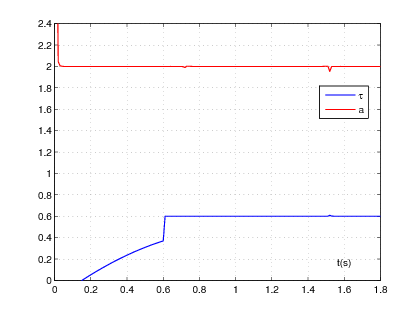Section: Scientific Foundations
Fast parametric estimation and its applications
Parametric estimation may often be formalized as follows:
where:
-
the measured signal
-
Finding a "good" approximation of the components of
-
differential algebra(Differential algebra was introduced in nonlinear control theory by one of us almost twenty years ago for understanding some specific questions like input-output inversion. It allowed to recast the whole of nonlinear control into a more realistic light. The best example is of course the discovery of flat systems which are now quite popular in industry.), which plays with respect to differential equations a similar role to commutative algebra with respect to algebraic equations;
-
module theory, i.e., linear algebra over rings which are not necessarily commutative;
-
operational calculus which was the most classical tool among control and mechanical engineers(Operational calculus is often formalized via the Laplace transform whereas the Fourier transform is today the cornerstone in estimation. Note that the one-sided Laplace transform is causal, but the Fourier transform over
Linear identifiability
In most problems appearing in linear control as well as in signal processing, the unknown parameters are linearly identifiable: standard elimination procedures are yielding the following matrix equation
where:
-
-
-
the entries of
-
the matrix
How to deal with perturbations and noises?
With noisy measurements equation (2 ) becomes:
where
Structured perturbations
A perturbation
By well known properties of the non-commutative ring of differential
operators, we can multiply both sides of equation (3 )
by a suitable differential operator
where the entries of the
Attenuating unstructured noises
Unstructured noises are usually dealt with stochastic processes like white Gaussian noises. They are considered here as highly fluctuating phenomena, which may therefore be attenuated via low pass filters. Note that no precise knowledge of the statistical properties of the noises is required.
Comments
Although the previous noise attenuation(It is reminiscent to what most practitioners in electronics are doing.) may be fully explained via formula (4 ), its theoretical comparison(Let us stress again that many computer simulations and several laboratory experiments have been already successfully achieved and can be quite favorably compared with the existing techniques.) with today's literature(Especially in signal processing.) has yet to be done. It will require a complete resetting of the notions of noises and perturbations. Besides some connections with physics, it might lead to quite new "epistemological" issues [80] .
Some hints on the calculations
The time derivatives of the input and output signals appearing in equations (2 ), (3 ), (4 ) can be suppressed in the two following ways which might be combined:
-
integrate both sides of the equation a sufficient number of times,
-
take the convolution product of both sides by a suitable low pass filter.
The numerical values of the unknown parameters
A first, very simple example
Let us illustrate on a very basic example, the grounding ideas of the algebraic approach, based on algebra. For this, consider the first order, linear system:
where
where
In order to eliminate the term
Recall that
For
Since
Note that equation (10 ) represents an on-line algorithm
that only involves two kinds of operations on
If we now consider an additional noise, of zero mean, in (5 ), say:
it will be considered as fast fluctuating signal. The order
This example, even simple, clearly demonstrates how algebraic's techniques proceed:
-
they are algebraic: operations on
-
they are non-asymptotic: parameter
-
they are deterministic: no knowledge of the statistical properties of the noise
A second simple example, with delay
Consider the first order, linear system with constant input delay(This example is taken from [69] . For further details, we suggest the reader to refer to it.):
Here we use a distributional-like notation where
where
The delay
where the
These coefficients show that
|
Figure 1 gives a numerical simulation with
Again, note the realization algorithm (15 ) involves
two kinds of operators: (1) integrations and (2) multiplications
by
It relies on the measurement of
and a linear system with unknown parameters
The resulting numerical simulations are shown in
Figure 2 . For identifiability reasons, the obtained
linear system may be not consistent for
|




